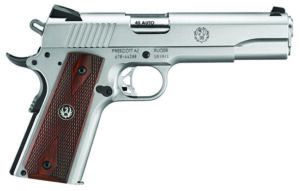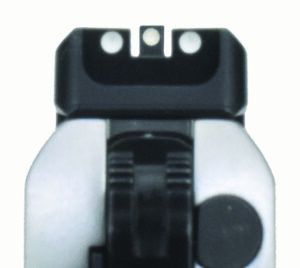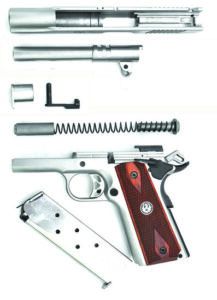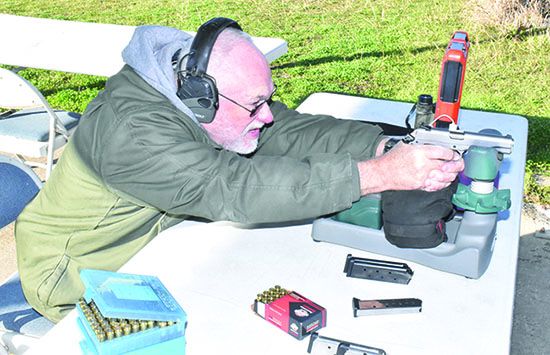Ranging in experience from the veteran of a few action-pistol matches to a few decades, all the members of the Houston test group are competitive shooters. Soon to recognize the 40th anniversary of his first USPSA match, the most ancient among the team has witnessed the pitfalls of the 1911 platform as a competition pistol, and he talks frequently about the advancements made in today’s offerings versus those of yesteryear. So our shooters thought you might like to see some solid examples of what makes today’s firearms better in many respects than what we had back in the day.
To do that, we chose as a base pistol a Series 70 Colt Government Model, a 50-plus-year-old pistol on loan to us. Slightly modified, we used it for illustration purposes only. The two modern-day handguns were a Ruger SR1911 Product No. 6700, a 45 ACP with a bead-blast stainless finish and contrasting controls, $929. Second is the very new Savage 1911 Govt Style Black Nitride 67200 with adjustable sights and forward cocking serrations, $1280. As you can see, the Savage costs a third again what the Ruger does, so we had to know if it was worth the difference. First, because you’re likely more interested in what current factory pistol you might want to buy, we detail how the Ruger and Savage shooters compare to each other. Then, at the end of this article, we illustrate what we feel are the major differences between them and our historical Colt.
The dinosaur in this test group shot his first USPSA match in April 1984 with a Series 70 Colt Government Model 1911 much like the sample in the photos on page 22. Little did he know how much he was going to have to spend before that pistol qualified as “match ready” for USPSA. Colt was the brand back then, along with some assistance from Springfield Armory. Both seemed to require that the shooter disassemble his pistol immediately upon purchase and take that bag of parts, along with more he ordered from Brownells or the like, to a talented gunsmith for tuning and reassembly. Wait times for the work were usually months, and costs were high. The new competitor could expect to pay around $1000 to the gunsmith, plus the cost of the base pistol, both in 1980 dollars, for something that would shoot accurately and work consistently.
Let’s face it, while the 1911 is an incredible design that is still relevant more than 110 years after its acceptance by the U.S. military, it had its weak points. John Moses Browning may be the greatest firearms inventor who ever lived, but the 1911 still needed its own generations of improvements to get to where it is today. The sights were too small, the barrel bushing was prone to breakage, accuracy was only fair, the trigger needed some help, and, amazingly, it was difficult to eject a loaded round. Add to that, the older gun had a lot of moving parts that needed to be kept somewhat clean to function.
Over the years, shooters and gunsmiths have learned what needed to be done to make the 1911 platform work, and to be honest, the 1911 still has quite a few parts that need some love. We find ourselves needing to maintain our 1911s more than, say, a Gen 5 Glock, and we now know where to and how much to lube the older pistols. We look back at those days and shake our heads at what we gripe about paying today and what we get for it.
Our comparison of the Ruger and Savage pistols highlight many features that weren’t available from the factory 50 years ago, but which are over-the-counter offerings today. Let’s dig into the new pistols:
Ruger SR1911 6700 45 ACP
$929
Gun Tests grade: A- [our pick]
The SR1911 does not have some of the bells and whistles present on the Savage, and some shooters may prefer that. What this pistol did was shoot accurately and function well at a very respectable price.

| Action | Semi-auto single action, hammer fired |
| Overall Length | 8.75 in. |
| Overall Height | 5.5 in. |
| Maximum Width | 1.367 in. |
| Weight Unloaded | 2.22 lbs. |
| Weight Loaded | 2.73 lbs. |
| Slide Material | Stainless steel |
| Slide Retraction Effort | 21.5 lbs. |
| Receiver Material | Stainless steel |
| Finish | Brushed stainless steel |
| Front Strap Height | 2.75 in. |
| Back Strap Height | 3.25 in. |
| Barrel | 5.0 in. long, 1:16 RH twist |
| Grip Thickness (Maximum) | 1.327 in. |
| Grip Circumference | 5.4 in. |
| Magazines | Stainless steel, (1) 7-round and (1) 8-round |
| Sights | Drift adj. Novak 3-Dot |
| Sight Radius | 6.5 in. |
| Trigger-Pull Weight | 3.77 lbs. |
| Trigger Span | 3.0 in. |
| Safeties | Manual thumb lever, grip |
| Warranty | None written |
| Telephone | (336) 949-5200 |
| Website | Ruger.com |
| Made In | U.S. |
These days, Ruger is producing a great 1911 for a hair more than $900 and, in doing so, fixing most of the problems we had decades ago. Good manufacturers, like Ruger and Savage, have learned how to make barrel lugs that fit tightly to the slide, improving lock-up and accuracy. The sighting system has advanced, progressing from a minimalist staked front sight to very visible units mounted in dovetails, just in case you don’t like the current height, shape, or color. Virtually all modern versions of the 1911 include an ejection port that has been totally reshaped. The port has been lowered on the right side and the front edge relieved to allow a full-length 230-grain hardball round to be ejected without issue. In addition, the rear edge of the port has been sculpted to create a shape that is easier on spent brass. Triggers, flared magwells, and controls have all been improved in fit and function in styles frequently unique to the manufacturer.

Ruger created a version of the 1911 that fits well with the company’s manufacturing traditions. We believe in the use of stainless steel for firearms, and our test sample features a stainless slide and frame. Both have a low-glare finish that looks like they have been bead blasted — and Ruger has managed to do so without rounding all those edges that need to stay sharp. Don’t worry, the front edge of the slide has been melted just a bit to allow for easier holstering.
Eight diagonal grasping grooves have been cut at the rear of the slide, while Ruger left the front of the slide slick. No grooves there. All the flats are flat, the edges are crisp, and no tool marks are visible. On inspection, the inside of the slide was almost as smooth as the outside.
The front-sight post is black with a single white dot and is mounted in a standard dovetail slot cut into the slide. Nothing is staked or pinned, so, if the shooter decides he wants something else, it should be easy to change. The rear sight is a true Novak unit and adheres to that company’s traditional styling. The medium-height rear blade is fixed for elevation, while the entire sight and mount can be moved in the dovetail to adjust for windage. The two-dot piece is locked down with a set screw. If you require a rear sight you can use for a “tap-rack,” this is not your sight, but it provides a great sight picture, and we love it.

All the little tricks we use to test for potential showed a solidly built pistol. The lugs on top of the 5-inch-long barrel and by the link were sharp and slid smoothly into their recesses. The solid barrel bushing was tight on the slightly oversized muzzle. It could be removed by hand, but a good bushing wrench came in very handy. Slide-to-frame fit was very good, with only a little end shake. Standard procedure is for us to check barrel movement with the slide in battery. We commonly find that the hood can be depressed just a hair. Not with this pistol. Lockup was solid. Even with the hammer cocked, there was just no movement felt at all — something that portends well for accuracy.
The frame also shows great improvement over the original design. Gone are the ears that protect the first-gen grip safety. They have been replaced by a nice, wide beavertail version. Early efforts by John Browning evolved into a spur hammer that, when fully extended to the rear, could easily pinch the web of the shooter’s hand, sometimes drawing blood. This elongated beavertail protrudes past that point, and with the help of a Doug Koenig–designed Commander-style hammer, eliminates that concern.
The grip safety also sports an enlarged pad at the lower end some call a memory bump. Serving to guide the hand to the correct spot on the pistol needed to achieve a proper grip, this bump also helps fill in the space provided by a less-than-meaty hand. The early arched mainspring housing (something a Glock aficionado switching to a 1911 might want to try) has been replaced by a flat version, checkered at around 30 lines per inch, that serves to lock the pistol in the shooter’s hand under recoil. The also-checkered magazine release is left side only, which is really no issue for a left hander — just depress it with the index finger of your strong hand. The manual thumb safety is also left side only, which is a bit more problematic. No worries though, there are plenty of aftermarket ambi-safeties around. We applaud Ruger’s and Savage’s decision to forego the Series 80-style firing-pin safety. In our opinion, the extra linkages required for the Series 80 only gum up the works of a good trigger. Heavier firing-pin springs and modern lightweight firing pins accomplish the same purpose with no degradation to the trigger pull.
Ruger added in more of their own touches in this pistol. All of the controls are matte black like the sights, making for an interesting contrast in colors. The magazine well has been beveled for easier reloads. An interesting final touch is the plunger tube. Containing a spring and detent pins for the slide release as well as the thumb safety, the original design has this part staked to the left side of the frame. This creates a part that can, all too often, work itself loose. The Ruger version is integral to the frame and should alleviate that concern.
Elsewhere, Ruger provides a single flush-fit seven-round magazine along with an extended eight-round mag, both with a polished stainless finish. We liked the hardwood grips with the Ruger logo. The points on the checkering could have been sharper, further aiding a good grip, but the color contrast was, once again, quite nice.
The skeletonized trigger required trigger compression of only 3.8 pounds, with about 1⁄8 inch of take up and very little overtravel. The recoil spring was another matter, requiring a good bit more effort than we’ve come to expect from a 45 ACP pistol. It reminded us more of an 18- to 20-pound spring instead of the more common 16.5-pound unit. Function was perfect for all factory ammunition. Our reloads were, apparently, a bit oversized and caused some problems for the SR1911 going into battery. A little more crimp on our end would probably solve the issue. To us, what we saw was an indication of a tight chamber, and that generally bodes well for accuracy. We didn’t ding the pistol for this malfunction.
Our Team Said: The SR1911 did not disappoint, averaging 1.44-inch five-shot groups at 15 yards for all ammo types combined. All three types of factory ammo shot very well, but a little to the left of point of aim. But that’s why we have a drift-adjustable sight.
| 45 ACP RANGE DATA | ||
| Black Hills HoneyBadger 135-grain Fluted Copper | Ruger SR1911 | Savage 1911 |
| Average Velocity | 1223 fps | 1202 fps |
| Muzzle Energy | 448 ft.-lbs. | 433 ft.-lbs. |
| Smallest Group | 1.27 in. | 1.15 in. |
| Average Group | 1.45 in. | 1.44 in. |
| Hornady Critical Defense 185-grain Jacketed HP | Ruger SR1911 | Savage 1911 |
| Average Velocity | 981 fps | 967 fps |
| Muzzle Energy | 395 ft.-lbs. | 384 ft.-lbs. |
| Smallest Group | 1.04 in. | 1.78 in. |
| Average Group | 1.39 in. | 1.85 in. |
| Remington Golden Saber 230-grain Jacketed HP | Ruger SR1911 | Savage 1911 |
| Average Velocity | 804 fps | 793 fps |
| Muzzle Energy | 330 ft.-lbs. | 321 ft.-lbs. |
| Smallest Group | 1.27 in. | 1.42 in. |
| Average Group | 1.48 in. | 1.78 in. |
How we tested: We fired these pistols at American Shooting Centers in West Houston. Accuracy was tested at 15 yards by shooting multiple five-shot groups from a well-sandbagged Caldwell Pistolero shooting rest (MidwayUSA.com Product No. 517357, $28) assisted by a Mini DRC Fortune Cookie from Wiebad.com ($75, Product No. MINIFC). We found our ammo through Ammoseek.com, firing Black Hills 135-grain HoneyBadgers, Hornady Critical Defense 185-grain JHPs, and Remington 230-grain Golden Saber JHPs. We function tested with a USPSA load consisting of Bayou Bullets 230-grain round-nose lead bullets, VihtaVuori N310 powder, and large pistol primers. Power factor (bullet weight x muzzle velocity/1000) was right at 168 (165 is required for USPSA major caliber scoring), and these are some of the softest competition loads we’ve ever shot.
| DRILL NO. 1 DATA | |
| Pistol | Single Shot Average Time |
| Ruger SR1911 | 0.743 |
| Savage 1911 Gov’t | 0.752 |
Process: Fire one shot from low ready at A Zone target (5-by-11 inches) placed at 8 yards. Numbers are averages for six repetitions. Times are in seconds.
| DRILL NO. 2 DATA | |||
| Pistol | 1st Shot | Split Average | Total Time |
| Ruger SR1911 | 0.96 | 0.24 | 1.455 |
| Savage 1911 Gov’t | 0.883 | 0.201 | 1.293 |
Process: Fire three shots from low ready at A Zone target (5-by-11 inches) placed at 8 yards. Numbers are averages for three repetitions. Times are in seconds.
| DRILL NO. 3 DATA | |||
|---|---|---|---|
| Pistol | 1st Shot | Split Average | Total Time |
| Ruger SR1911 | 0.845 | 0.216 | 1.693 |
| Savage 1911 Gov’t | 0.855 | 0.208 | 1.707 |
Process: Fire five shots from low ready at A Zone target (5-by-11 inches) placed at 5 yards. Numbers are averages for three repetitions. Times are in seconds.
Written and photographed by Joe Woolley, using evaluations from Gun Tests Team members. GT




























Disregard my registration and request.
Great article. Joe Woolley is great writer
Maybe…I’ll visit a local shop/range rental and try one , if there is a Ruger for renting. Same for the Savage. Thanks for the report n write up.
where is info on savage 1911?